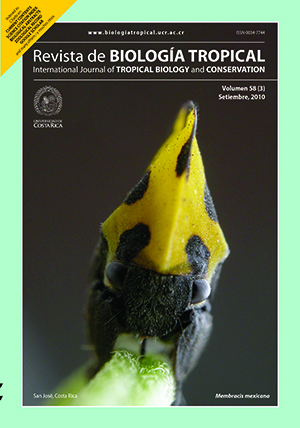Abstract
The brown-nosed coati (Nasua nasua) is a carnivorous species found in all the Brazilian biomes, some of which are endangered areas. The aim of this work was to determine the habitat use and selection, home range and core area of N. nasua in the Cerrado biome, central region of Tocantins, Brazil. The study was carried out in an area of approximately 20 000ha from May 2000 to July 2002. A total of seven box traps were placed in the area for 13 months, three of 11 captured animals were followed and monitored by radio-tracking during 13 months. The monitoring was conducted once a day, three times a week using a car and walking through the study area (radio-tracking and visual contact). The results demonstrate that these three males used more frequently the gallery forest formation, followed by cerrado and wetlands. The use of gallery forest by these animals indicated an habitat selection (Proportion test, z=12.98, p < 0.01). Besides, adult males used the gallery forest more frequently (Fisher's exact test, p < 0.01) and wetlands less frequently (Fisher's exact test, p < 0.01) than juvenile males, without significant differences between animal ages for cerrado percentage of habitat use. Besides, results also showed a gallery forest selection by adult (Proportion test z= 13.62, p < 0.01) and juvenile (Proportion test z=2.68, p < 0.01) males, and a wetland selection by the juvenile male (Proportion test z=3.90, p < 0.01). The home ranges varied from 2.20 to 7.55km2 for the Minimum Convex Polygon 100% (MCP 100%) and from 4.38 to 13.32km2 for the Harmonic Mean 95% (HM 95%). The smallest home range overlap occurred between the adult males (Nm1 and Nm3), and the greatest between the juvenile Njm2 and the adult Nm1. The average of the core area (HM 75%) for the three monitored animals represented 21.29% of the home range calculated with HM 95%. No overlap between core areas was observed for adult males, but, it was an overlap between the core area of the juvenile male and its band with that of the two adult males. The present study provides new data on core area size and frequency habitat use by adult and juvenile males of N. nasua in the Brazilian Cerrado, that may support conservation efforts. Rev. Biol. Trop. 58 (3): 1069-1077. Epub 2010 September 01.Comments

This work is licensed under a Creative Commons Attribution 4.0 International License.
Copyright (c) 2010 Revista de Biología Tropical
Downloads
Download data is not yet available.






